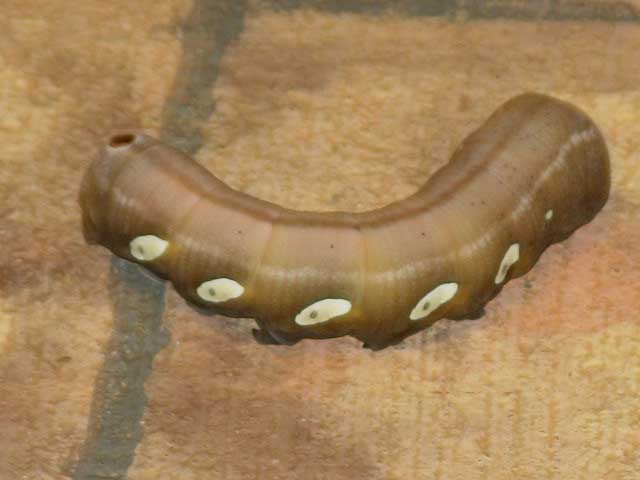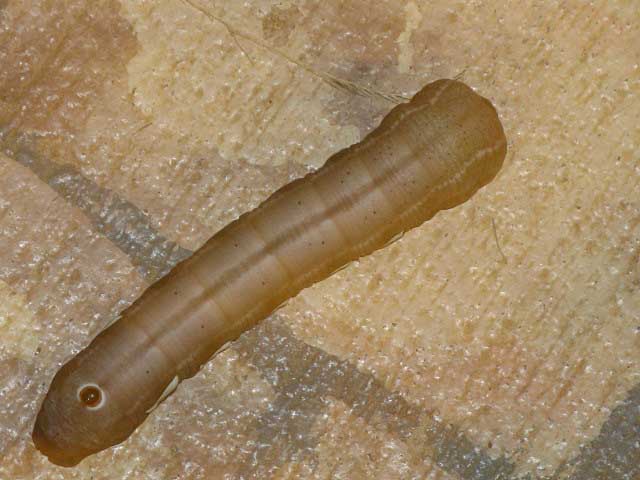
Eumorpha pandorus, fifth instar, lateral, Lubbock County, Texas,
September 2008, courtesy
of Jennifer Z. Davis.
|
|
Created/dedicated as per personal communication with Jennifer Z. Davis, September 2008 Updated as per Butterflies and Moths of North America, formerly USGS, September 2008 Updated as per James P. Tuttle's The Hawk Moths of North America, July 24, 2010 Updated as per personal communication with Linda Mitchell, July 24, 2010 |

Eumorpha pandorus, fifth instar, lateral, Lubbock County, Texas,
September 2008, courtesy
of Jennifer Z. Davis.
Jennifer writes, "I am in West Texas. I have never seen one of these, and I was trying to find out what kind of caterpillar it was. I haven't found any pictures that are like this one. It's the length of a cigarette lighter. I put one next to it in one of the pictures. It's smooth, gray in color with white spots down its side and black on bottom. It has one black dot on its back. It was on my front patio just sitting there. When I poked it with a stick to see if it was alive, it starting slowly going back out towards my yard."
I replied, "It is Eumorpha pandorus, the Pandorus Sphinx. I would like permission to use some of the images with credit to you on a western Texas webpage. Please provide me with the west Texas County.
Generally this is a more easterly species, not reported west of eastern Texas."
"You have my permission! Lubbock County, I am in the City of Lubbock.
"Thank you- my kids were amazed by it and wanted to know what it was. Like I said I've never seen one that looked like that. We usually only have the black furry
ones around here.
"Thank you again."
For care of "found larvae/caterpillars" visit Manduca sexta larva, central Texas, August 21, 2008, Trina Woodall.
Seventy-five Sphingidae species are listed for Texas on the U.S.G.S. website. Not all of the species are reported or anticipated in the northwest central region. It is hoped that this checklist, with the thumbnails and notes, will help you quickly identify the caterpillars you are likely to encounter. Some occurin more than one form so click on the links if you find something similar that is not a perfect match.
A "USGS" indicates the moth is reported on the USGS website and/or in Lepidoptera of North America, #1. Distribution of Silkmoths (Saturniidae) and Hawkmoths (Sphingidae) of Eastern North America, an excellent little booklet available through Paul Opler.
Please help me develop this list with improved, documented accuracy by sending sightings (species, date, location), preferably with an electronic image, via email to Bill Oehlke.
Sphinginae subfamily
Smerinthini Tribe:
Macroglossinae subfamilyDilophonotini tribe:
See Hemaris comparison to help distinguish the next two species.
Philampelini tribe:
Macroglossini tribe:
|

Eumorpha pandorus, fifth instar, dorsal, Lubbock County, Texas,
September 2008, courtesy
of Jennifer Z. Davis.
Enjoy some of nature's wonderments, giant silk moth cocoons. These cocoons are for sale winter and fall. Beautiful Saturniidae moths will emerge the following spring and summer. Read Actias luna rearing article. Additional online help available.
Eggs of many North American species are offered during the spring and summer. Occasionally summer Actias luna and summer Antheraea polyphemus cocoons are available. Shipping to US destinations is done from with in the US.
Use your browser "Back" button to return to the previous page.
This page is brought to you by Bill Oehlke and the WLSS. Pages are on space rented from Bizland. If you would like to become a "Patron of the Sphingidae Site", contact Bill.
Please send sightings/images to Bill. I will do my best to respond to requests for identification help.
 Show appreciation for this site by clicking on flashing butterfly to the left. The link will take you to a page with links to many insect sites. |